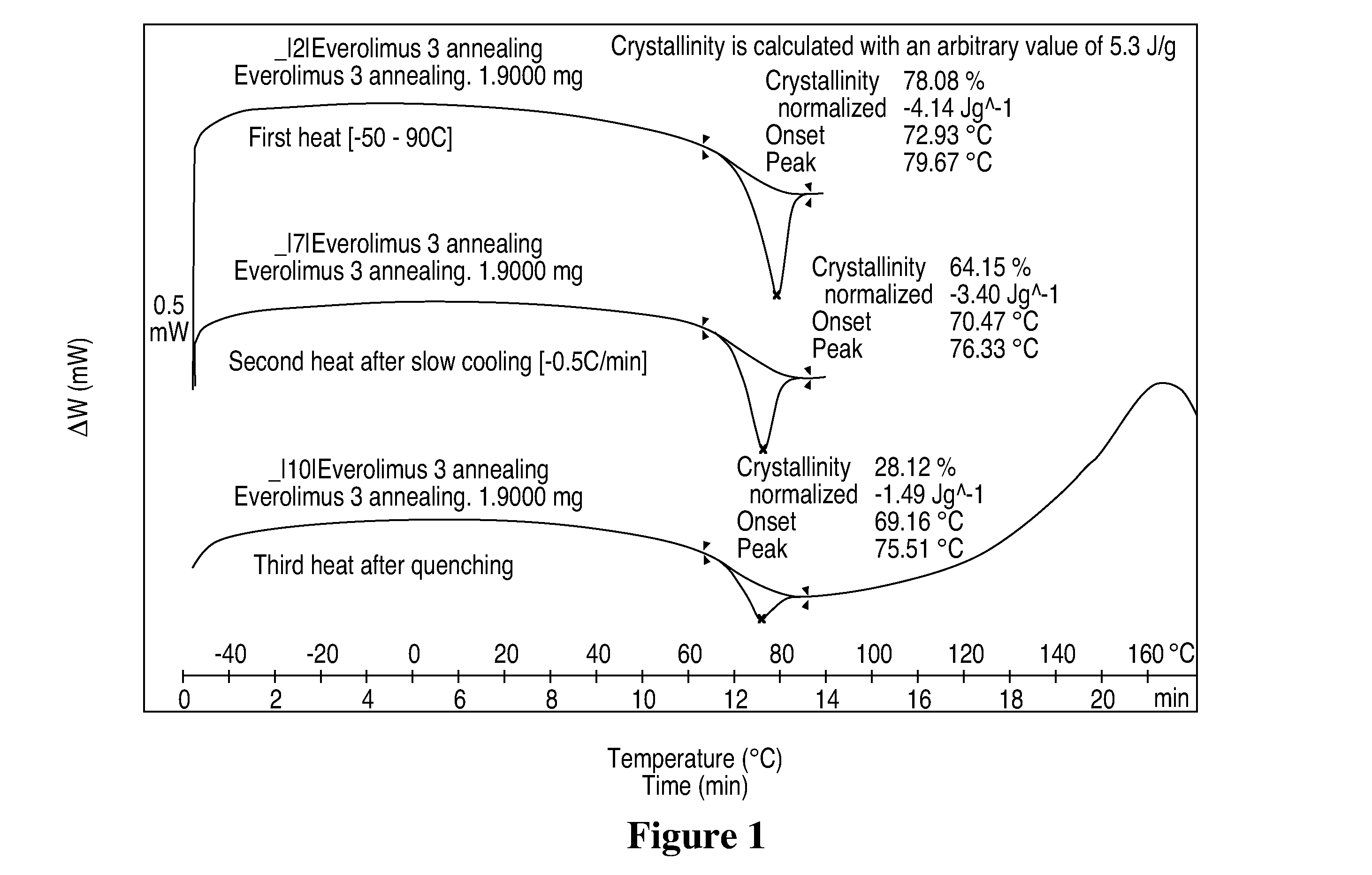Methods of Forming Coatings with a Crystalline or Partially Crystalline Drug for Implantable Medical Devices
a technology of drugeluting and coatings, which is applied in the direction of pharmaceutical containers, packaging foodstuffs, packaged goods, etc., can solve the problems of inability to use polyactiveTM as a matrix polymer, and provide an inadequate platform for the delivery of drugs
- Summary
- Abstract
- Description
- Claims
- Application Information
AI Technical Summary
Benefits of technology
Problems solved by technology
Method used
Image
Examples
example 1
[0049]Vision 12 mm small stents were coated with the following configuration:
[0050]Primer: a stent was coated with 100 μg PolyActive™ in 2 w t % PolyActive™ (400PEGT80PBT20) solution with mixture of 1,1,2-trichloroethan and chloroform (80 / 20 by volume), and then baked at 50° C. for 1 hour.
[0051]Drug layer: 120 μg pure 40-O-(2-hydroxy)ethyl-rapamycin (everolimus) in 2 wt % drug solution dissolved in acetone / xylene (60 / 40 by volume); baked at 50° C. for 1 hour.
[0052]PolyActive™ layer: 300 μg PolyActive™ in 2 wt % PolyActive™ (300PEGT55PBT45) solution with mixture of 1,1,2-trichloroethan and chloroform (80 / 20 by volume); baked at 50° C. for 2 hours.
[0053]Results
[0054]The drug release data for the stent coated with this formulation and configuration indicated a release of 100% at 3 hours in porcine serum.
example 2
[0055]Vision 12 mm small stents were coated according to the following configuration:
[0056]Primer: A stent was coated with 200 μg PolyActive™ in 2 wt % PolyActive™ (400PEGT80PBT20) solution with mixture of 1,1,2-trichloroethan and chloroform (80 / 20 by volume).
[0057]After 200 μg polymer coating, the stent was coated another 2 pass of polymer (about 30 μ / pass) and blow dried; the stent was placed into a vial containing 40-O-(2-hydroxy)ethyl-rapamycin (everolimus) powder. By shaking the stent in the powder, about 200 μg drug was coated onto the stent. The stent was coated with two passes of PolyActive™, and followed by drying at 50° C. for 1 hour.
[0058]Results
[0059]The drug release data for the stent coated with this formulation and configuration showed a release of about 88% of the drug at 24 hours in porcine serum.
example 3
[0060]Vision 12 mm small stent were coated according to the following configuration:
[0061]Primer: A stent was coated with 200 μg PolyActive™ in 2 wt % PolyActive™ (300PEGT55PBT45) solution with mixture of 1,1,2-trichloroethan and chloroform (80 / 20 by volume).
[0062]After 200 μg polymer coating, the stent was coated another 2 pass of polymer (about 30 μ / pass) and blow dried; the stent was placed into a vial containing 40-O-(2-hydroxy)ethyl-rapamycin (everolimus) powder. By shaking the stent in the powder, about 200 μg drug was coated onto the stent. The stent was coated with two passes of PolyActive™, and followed by drying at 50° C. for 1 hour.
PUM
 Login to View More
Login to View More Abstract
Description
Claims
Application Information
 Login to View More
Login to View More - R&D
- Intellectual Property
- Life Sciences
- Materials
- Tech Scout
- Unparalleled Data Quality
- Higher Quality Content
- 60% Fewer Hallucinations
Browse by: Latest US Patents, China's latest patents, Technical Efficacy Thesaurus, Application Domain, Technology Topic, Popular Technical Reports.
© 2025 PatSnap. All rights reserved.Legal|Privacy policy|Modern Slavery Act Transparency Statement|Sitemap|About US| Contact US: help@patsnap.com


